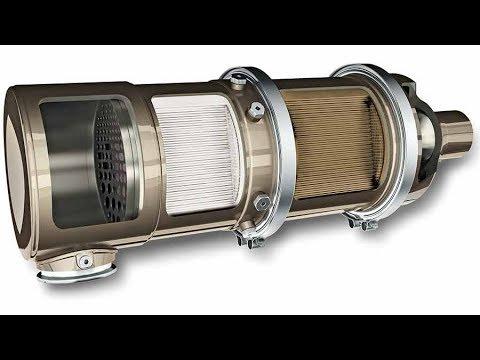Beyond the Soot: The High-Tech Evolution of Diesel Filtration Systems

The narrative around diesel technology is shifting from one of obsolescence to one of transformation, and at the center of this change is the diesel particulate filter. No longer a simple filter, it has become a high-tech, connected component integral to the health of the engine and the environment. With urban air quality a top priority for cities worldwide, the development of these systems represents a crucial bridge technology, ensuring existing diesel fleets can operate cleaner while the world transitions to alternative powertrains.
The financial investment in this transition is substantial. According to Straits Research, "The global diesel particulate filter market size was valued at USD 15.66 billion in 2024 and is expected to grow from USD 16.86 billion in 2025 to reach USD 30.53 billion by 2033, growing at a CAGR of 7.7% during the forecast period (2025-2033)." This growth is not just about new vehicles; a significant portion is driven by the lucrative retrofit and replacement sector, as fleet operators seek to extend the life of existing assets in compliance with new laws.
Competitive Analysis: The Race for Efficiency and Durability
Competition is fierce, with companies differentiating themselves through material science, system integration, and data-driven services.
-
Mann+Hummel (Germany): This filtration expert has expanded aggressively into the automotive space. Their recent innovations include "catalyzed" DPFs, where the filter itself is coated with a catalyst to aid regeneration and reduce the overall size of the aftertreatment system, a key advantage for compact vehicle designs.
-
Johnson Matthey (UK): A leader in catalysis, Johnson Matthey's expertise is in developing advanced coating formulations that lower the temperature required for passive soot oxidation, making the regeneration process more efficient and reducing fuel penalty. Their focus is on providing complete catalyst-coated substrate solutions to OEMs.
-
Dinex (Denmark): A strong player in the retrofit and off-road segment, Dinex has been active in launching new product lines compliant with the latest EU Stage V standards for non-road mobile machinery. They have also developed a strong presence in providing emission control solutions for marine and power generation applications.
-
Hussain Manufacturing Ltd. (India): Representing the growth in emerging economies, companies like Hussain are becoming key regional suppliers. They focus on cost-effective yet reliable DPF solutions for the price-sensitive Indian and Southeast Asian commercial vehicle markets, often through technology partnerships with European firms.
-
Corning Incorporated (USA): A pioneer in ceramic substrates, Corning's "DuraTrap" filter technology is a industry standard. Their continuous R&D focuses on increasing ash storage capacity (extending service intervals) and improving the mechanical durability of the ceramic filters to withstand vibration and thermal shock.
Growth Fueled by Retrofit and Circular Economy Trends
Beyond OEM fitment, several key trends are propelling the industry forward.
-
The Retrofit Revolution: Cities like London, with its Ultra Low Emission Zone (ULEZ), and others across Europe are forcing older commercial vehicles to be retrofitted with certified DPFs. This has created a booming secondary market, with companies like ETC (Emission Control Technologies) in the UK specializing in these complex installations.
-
Telematics and Predictive Maintenance: Modern DPFs are becoming connected. Data on backpressure, temperature, and regeneration cycles is fed into telematics systems. This allows fleet managers to predict maintenance needs, schedule cleanings, and avoid costly downtime, turning the DPF from a cost center into a managed asset.
-
Ash Cleaning and Recycling Services: A DPF can last the life of a vehicle if properly maintained. This has given rise to a new service industry dedicated to specialized cleaning processes that remove accumulated ash (from engine oil), restoring filter function. Companies are also exploring the recycling of precious metals from spent catalysts.
-
Material Advancements: Research into new substrate materials, including advanced metals and new composite ceramics, aims to create filters that are lighter, more efficient, and capable of handling the exhaust profiles of hybrid diesel engines, which have different thermal cycles.
Recent News from the Front Lines
The industry's development is highlighted by strategic moves and technological announcements.
-
Germany: Mercedes-Benz Trucks announced a new generation of its OM 471 engine series, featuring a completely redesigned aftertreatment system with a close-coupled DPF for faster warm-up and reduced emissions during cold starts, a key focus of Euro 7.
-
United Kingdom: A partnership between Johnson Matthey and Perkins Engines was announced to develop a new aftertreatment system for next-generation industrial engines, highlighting the collaboration between specialty chemical firms and engine OEMs.
-
North America: Cleaire Advanced Emission Controls (a subsidiary of Cummins) launched a new DPF system specifically approved for retrofit applications on older freightliner and Peterbilt trucks to bring them into compliance with California's strict air quality rules.
-
Global: The International Maritime Organization (IMO) is enforcing tighter Tier III emissions standards for ships, creating a massive new avenue for marine-grade DPFs. Companies like Wärtsilä (Finland) are at the forefront of scaling this technology for the shipping industry.
- Art
- Causes
- Crafts
- Dance
- Drinks
- Film
- Fitness
- Food
- Games
- Gardening
- Health
- Home
- Literature
- Music
- Networking
- Other
- Party
- Religion
- Shopping
- Sports
- Theater
- Wellness


